Open Your Heart for Two-Legged Inverted Staff
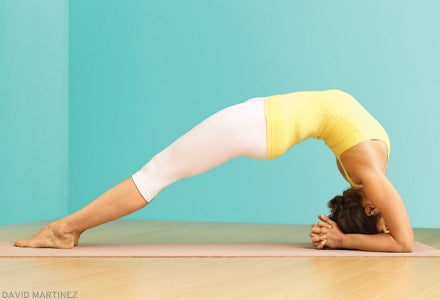
There’s a lot of talk these days about heart opening and following your heart. Spiritual teachers and self-help authors urge us to open our hearts. And many yoga styles, including Anusara Yoga, the method that I practice and teach, have reputations for focusing on heart opening.
Why is opening the heart so important? Because all of us have, at one time or another, been hurt by deep loss or betrayal that caused us to armor or protect our hearts. Whether you’ve been brokenhearted by a relationship or a huge loss, it’s natural to put up a protective shield that prevents you from getting close to people. But your deepest wounds can also be opportunities for growth and transformation. By learning to open your heart, you’ll gradually be able to forgive, let go of resentment, and release fear. You’ll also be able to let people in again. Ultimately, when you live with an open heart, you’ll experience more love and joy. You’ll be better able to listen to people, to accept them for who they are, and to respond to them from your deepest essence, which you access through the heart.
Backbending poses open the heart area physically and energetically and set the foundation for having a more open heart in your daily life. They require steady effort and an ability to surrender to something bigger that is always there to support you. This is called Opening to Grace, and it is the first of the five principles of Anusara Yoga.
Dwi Pada Viparita Dandasana (Two-Legged Inverted Staff Pose) is a deep, heart-opening backbend that depends upon a lot of patience and self-awareness. It is a profound undertaking whether you are flexible or tight. Students with tight shoulders will need to focus on breathing deeply to help gradually soften and open the area.
But the pose is no breeze for relatively flexible students either: Their challenge is to refrain from collapsing or hyperextending the shoulders while they breathe and soften the upper back. (Students with loose or weak shoulders sometimes have a relatively stiff upper-back area, since weakness in one area often causes holding or tightness in others.)
As you move through the sequence that follows, acknowledge that opening your heart—in yoga or in your life—requires both vulnerability and the ability to stay centered in self-awareness. And trust that over time, as your heart begins to open, you will begin to feel so in tune with your own wisdom that you will more easily allow others to follow their own heart’s desire. You will feel a strong foundation of love within, and you will enjoy the gifts that come when you love others and see their true essence.
Before You Begin
Build your inner fire with some Ujjayi Pranayama (Victorious Breath) and Sun Salutations. Take Adho Mukha Vrksasana (Handstand) at the wall, keeping the heads of your arm bones back as you press the bottom tips of your shoulder blades in toward your heart.
Go through a series of simple standing poses such as Virabhadrasana I (Warrior Pose I), Virabhadrasana II (Warrior Pose II), Parsvakonasana (Side Angle Pose), Trikonasana (Triangle Pose), Parivrtta Trikonasana (Revolved Triangle Pose), Parivrtta Parsvakonasana (Revolved Side Angle Pose), and Parivrtta Ardha Chandrasana (Revolved Half Moon Pose). These poses will build heat and soften your muscles.
Janu Sirsasana (Head-of-the-Knee Pose) and seated poses, such as Parivrtta Janu Sirsasana (Revolved Head-of-the-Knee Pose), Hanumanasana (Monkey God Pose), Baddha Konasana (Bound Angle Pose), and Malasana (Garland Pose) will strengthen your inner thighs while warming up your lower back and hips. Practicing these positions will ultimately make it easier to connect from your feet and legs all the way through your hips, and into your heart. Finally, Sirsasana (Headstand) and Sarvangasana (Shoulderstand) are unsurpassed for integrating and softening the muscles of your arms and upper back. These poses prepare you to support the incredible heart opening of Dwi Pada Viparita Dandasana.
Virabhadrasana I (Warrior Pose I), variation
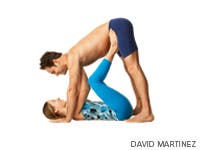
Virabhadrasana I provides a strong sense of power and grace. When you root down firmly through your legs, your upper body will feel supported and your heart will open. Begin by taking a wide stance. Invoke the first principle of Anusara Yoga and Open to Grace by softening your exterior armor and opening to a greater power that supports you. With the courage of a warrior, engage the muscles on all four sides of each leg (using the second principle of Anusara, or Muscular Energy). Turn your left foot and leg in about 60 degrees and turn your right foot out 90 degrees. Square your hips toward your right leg.
Engage your upper-inner thighs, lift the arches of your feet, and hug your shins in toward the midline of your body. Next, apply the Inner Spiral: Bend your right leg, lean forward, and rest your hands on your right thigh. Spiral your upper-inner thighs back, keep hugging your shins to the midline, and take the top of your sacrum in and up. Next, take your tailbone down as you extend and lengthen your spine all the way up through your neck and head.
Keeping the sides of your body long, take the heads of your arm bones back and feel the muscles of your upper back engage. Clasp your hands behind your back. Be sure to use a strap if your shoulders are stiff. Lift and open your heart by pressing the bottom tips of your shoulder blades into your back. As you do these actions, be sure not to tighten your trapezius muscles or block the area just below the shoulder blades.
As you stay for three full breaths, you can begin to expand out toward the periphery of your body with Organic Energy. Take the bottom of your sacrum down to scoop your tailbone as you bend your right leg even deeper.
Extend out through your spine, and move the top of your head back with faith and fearlessness. Inhale and draw energy from your legs and arms into the core of your pelvis (you’ll feel your pelvic core lift and engage when you take your thighs back and tailbone down; this is akin to the lift of Mula Bandha, or Root Lock). With each exhalation, simultaneously extend energy down through your legs and up through your heart, neck, and head.
As you reach down through your back leg, the sides of your body will lengthen and your heart will lift. Taking your energy in two directions like this can keep you feeling clear of pain or obstruction in the lower back. Repeat the pose on the other side, holding for three deep breaths.
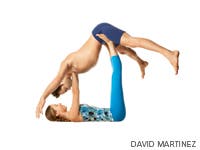
Eka Pada Rajakapotasana II (One-Legged King Pigeon Pose II), variation
Eka Pada Rajakapotasana II creates resilience in the quadriceps muscles. Having flexible and strong quadriceps provides more freedom and heart opening in backbends.
From Downward-Facing Dog, bring your right foot forward between your hands and take your left knee to the earth for a deep lunge. Take a deep breath and be fully present in this moment. Bend your left leg and hold the top of your left foot. Engage the muscles of your legs, spread your toes, lift your arches, and hug your shins to the midline of your body. Deconstruct the pose, taking your thighs back and apart to bring your left foot closer to your left buttock. Isometrically press your left foot back against your hand as you drag your left knee forward. Take the tops of both thighs back again and descend into a deeper lunge. From there, root down fiercely from the core of your pelvis through your left thighbone and knee and into the earth while keeping your right leg stable and strong.
The balanced pulsation of Muscular Energy drawing in and Organic Energy expanding out will give you support to soften and open your quadriceps muscles, thus enabling you to bend backward with greater ease. If you can combine these two principles, you’ll find the key to freedom in this deep thigh stretch.
Reach your right arm up and spread your fingers. Engage your arm muscles and draw the head of your arm bone deep into your shoulder socket. Open and lift your heart by pressing the bottom tips of your shoulder blades into your upper back. Extend down through the core of your pelvis and legs and up through your head, arm, and hand as you open and soften your heart courageously.
Stay in this pose for three slow breaths, then release and change legs. It is helpful to practice this pose twice or even three times on each side for more depth, clarity, and understanding.
Pincha Mayurasana (Forearm Balance), variation
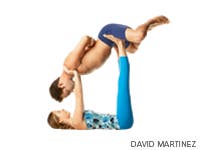
Pincha Mayurasana requires you to strongly connect your arm bones into the shoulder sockets by using the muscles of your upper back. When you learn to make this connection, you will begin to understand the difference between pushing through the armpits, or hyperextending the shoulder joints, and truly opening your heart.
Before you go upside down, practice this action: While standing, bring your arms overhead and bend your elbows so that the forearms are facing the ceiling. It will be like doing Forearm Balance standing up. Draw the heads of your arm bones back and down so that they connect deep within your shoulder sockets. Keeping that connection, press the bottom tips of your shoulder blades into your chest to open your heart. This is true heart opening. It is subtle and deep, and it does not involve force. In all backbends, your shoulders should remain stable, with the opening coming from your upper back.
Kneel down near a wall and place a block against it, horizontally. Place your forearms on the floor, parallel to one another and shoulder-distance apart. With the pinky side of your hands resting on the floor, palms facing toward each other, wrap your fingertips around the block and gently squeeze it to strengthen your upper-inner arms. Pause, bow your head, and exhale. Empty yourself of self-limiting beliefs and make room inside for something new to unfold. Relax your neck and allow your head to hang.
Next, inhale and take your triceps muscles toward the wall—this will help connect the arm bones into the shoulder sockets. Lengthen the sides of your body generously. Exhale and release the back of your heart toward the earth, right between your shoulder blades. With each inhalation continue to lengthen the sides of the body. With each exhalation gradually soften your heart. Maintaining this steady action, tuck your toes under, lift your knees off the floor, and raise your hips to the sky. Take a step in and kick up to the wall lightly, one leg at a time.
With your heels on the wall, extend through your feet and toes and gradually press your thighs and hips back until they reach the wall. If you are tight, you might not be able to take your thighs all the way back, so be patient and use good judgment. With fortitude and resolution, inhale and practice Inner Spiral, taking the top of your thighs and your triceps muscles toward the wall. Exhale and soften—your heart is now freer and more able to extend out with generosity. As you keep your arm bones moving back in connection with your highest vision, continue to soften your heart, opening it from the back to the front.
It is often easier for most people to hang their head and look into the middle of the room in order to engage the shoulders and upper back. Eventually, for some people, it is more powerful to take the top of your ears and the sides of your neck back so that you are looking at the block. This action strengthens the neck and upper-back muscles, prevents collapsing through the armpits, and ultimately deepens the opening of the heart. Stay in this pose for three breaths. Come down gently, rest, and repeat.
Urdhva Dhanurasana (Upward Bow Pose), variation
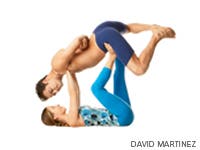
As you move closer to the final pose, you’ll continue to learn how to soften and open your heart safely. Lie on your back with your knees bent, your feet flat on the floor, and your head near the wall. Place your feet hip-width apart, with your hands by your ears a little wider than shoulder distance. Soften and open to the support of the universe that is always present for you in everything you do.
Inhale and draw energy from your hands and feet into the core of your pelvis. Exhale and extend Organic Energy from your core through your legs and into your feet as you lift your hips and head off the floor. Rest on the top of your head and place the heels of your hands near the wall. Soften the muscles of your upper back and shoulders. Move your elbows away from the wall and plug the heads of your arm bones into your shoulder sockets to connect into your heart and all that supports you. Keeping that connection, press the bottom tips of your shoulder blades into your back, toward the bottom of your heart.
Begin to roll toward your forehead, protecting your neck by strongly engaging the hands, arms, shoulders, and upper back. If your neck feels compromised or your trapezius muscles become blocked, back off slightly and soften with your breath. From there, inhale and draw energy from your hands and feet into the core of your pelvis. Exhale, pick a drishti (gaze) on the floor, and, keeping your eyes on it, push yourself up.
Curl your head back, with the tops of your ears following, and look at your fingertips. For maximum benefit, challenge yourself to bring your heart to the wall while you keep your head, chin, and heads of your arm bones moving away from it. This work presents a great physical and, for some, emotional challenge. If you find it difficult to trust another person with your heart, you must first find the deep connection within yourself. The back of the body represents universal consciousness, while the front represents individual consciousness. By plugging into and connecting with the back of the heart first, you will feel more connected to others, less afraid, and less needy. When you feel this way, you’ll be able to love more fully without feeling as though you will lose yourself. When you feel connected to yourself and to universal consciousness, you will be less likely to give up your power, which will make all of your relationships feel more balanced and enjoyable. Anything out of balance will demand either a change or an ending.
Dwi Pada Viparita Dandasana (Two-Legged Inverted Staff Pose)

Lie on your back with your legs bent and your feet flat on the floor. Take a deep breath in and exhale completely as you Open to Grace. Place your hands by your ears and make sure your legs and feet are parallel to each other. Inhale and draw in to your center. Exhale, lift your hips, and push yourself up into Urdhva Dhanurasana. Bend your elbows and place the top of your head on the floor. One at a time, bring your forearms alongside your head and interlace your fingers behind it. Inhale and expand from within. Exhale and soften. On your next inhalation connect your shoulders with their sockets by drawing the heads of your arm bones back and pressing the bottom tips of both shoulder blades forward.
Exhale and press down through your wrists and forearms as you lift your head up off the floor. Inhale and be sure that the heads of your arm bones are still in their sockets. Curl your head back and exhale as you move your heart forward with both power and sensitivity. Repeat this action with patience and steady breathing. Support the opening of your heart by lengthening from the core of the pelvis and out through your legs and feet.
One by one, walk your feet out until your legs straighten. As you do this, take your time and continue steady breathing. It requires steadiness to protect the lower back while opening the heart and extending through the legs.
Once you feel steady in the pose, make it an offering. Inhale to open to a feeling of connection with something bigger and more eternal. Exhale to become softer, brighter, and more at ease. If you are tensing up or gripping, you may be trying too hard. In matters of the heart, we must learn cooperation rather than willfulness. Stay for three full breaths and try the pose once or twice more.
To cool down, lie on your back and reach your right leg to the sky in a variation of Supta Padangusthasana (Reclining Hand-to-Big-Toe Pose). Hold on to the back of your thigh as you press your thighbone against your hands and ground your left leg deeply into the earth. Breathe steadily and feel your lower back release. Repeat with the other leg.
From there, stretch your arms out to the sides, palms facing up. Press your head back and lift your heart with the bottom tips of the shoulder blades. Extend this vibrant energy out through your fingertips. Inhale and draw your knees over your hips. Exhale and take your legs over to the right into Jathara Parivartanasana (Revolved Abdomen Pose) for two breaths. Do both sides.
From a seated position, come into Paschimottanasana (Seated Forward Bend). Inhale, lengthen the sides of your body, and fold forward to hold the tips of your toes. Exhale and root down from the core of your pelvis through your feet. Place your hands on your outer shins and squeeze them toward the midline as you push your thighs apart.
As you rest in Savasana (Corpse Pose), take a moment to recall how you connected to something much bigger than yourself. Celebrate every little spark of awareness and connection that you can truly feel as you continue to follow your heart in this journey of life and love.